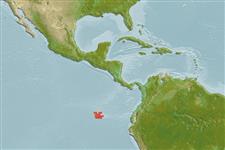Teleostei (teleosts) >
Clupeiformes (Herrings) >
Dorosomatidae (Gizzard shads and sardinellas)
Etymology: Opisthonema: Greek, opisthe = behind + Greek,nema = filament (Ref. 45335).
Eponymy: Father Tomás de Berlanga (1487–1551) was the fourth Bishop of Panama (1534). [...] (Ref. 128868), visit book page.
Environment: milieu / climate zone / depth range / distribution range
Ecology
Marine; pelagic-neritic; depth range 0 - 50 m (Ref. 188). Tropical; 3°N - 4°S, 94°W - 89°W (Ref. 188)
Southeast Pacific: endemic to the Galapagos Islands.
Size / Weight / Age
Maturity: Lm ? range ? - ? cm
Max length : 26.0 cm SL male/unsexed; (Ref. 188); common length : 18.0 cm SL male/unsexed; (Ref. 188)
Dorsal spines (total): 0; Dorsal soft rays (total): 13 - 21; Anal spines: 0; Anal soft rays: 15 - 17. The filamentous last dorsal fin ray distinguishes this species from members of any other eastern Pacific clupeoid genus. Lower gill rakers 50 to 87 in fishes over 14 cm standard length (intermediate between O. medirastre with 41 to 69 and O. libertate with 63 to 110, but neither of these occur in the Galapagos Islands).
Forms schools.
Life cycle and mating behavior
Maturity | Reproduction | Spawning | Eggs | Fecundity | Larvae
Whitehead, P.J.P., 1985. FAO Species Catalogue. Vol. 7. Clupeoid fishes of the world (suborder Clupeoidei). An annotated and illustrated catalogue of the herrings, sardines, pilchards, sprats, shads, anchovies and wolf-herrings. FAO Fish. Synop. 125(7/1):1-303. Rome: FAO. (Ref. 188)
IUCN Red List Status (Ref. 130435: Version 2024-2)
Threat to humans
Harmless
Human uses
Fisheries: subsistence fisheries
Tools
Special reports
Download XML
Internet sources
Estimates based on models
Preferred temperature (Ref.
123201): 14.5 - 23.7, mean 19.3 °C (based on 4 cells).
Phylogenetic diversity index (Ref.
82804): PD
50 = 0.5312 [Uniqueness, from 0.5 = low to 2.0 = high].
Bayesian length-weight: a=0.00871 (0.00415 - 0.01826), b=3.06 (2.89 - 3.23), in cm total length, based on LWR estimates for this (Sub)family-body shape (Ref.
93245).
Trophic level (Ref.
69278): 3.3 ±0.4 se; based on size and trophs of closest relatives
Resilience (Ref.
120179): High, minimum population doubling time less than 15 months (Preliminary K or Fecundity.).
Fishing Vulnerability (Ref.
59153): Low vulnerability (22 of 100).
Nutrients (Ref.
124155): Calcium = 175 [97, 371] mg/100g; Iron = 1.71 [0.94, 3.00] mg/100g; Protein = 19.2 [18.0, 20.4] %; Omega3 = 0.442 [0.231, 0.860] g/100g; Selenium = 36.6 [17.6, 89.3] μg/100g; VitaminA = 43.8 [14.7, 136.6] μg/100g; Zinc = 1.05 [0.70, 1.62] mg/100g (wet weight);
